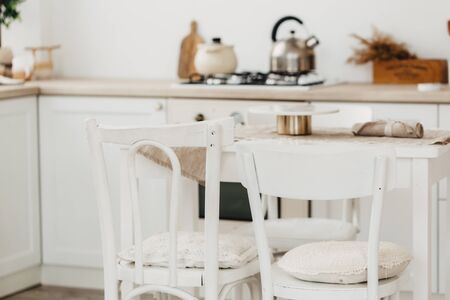Understanding the British Farmhouse Aesthetic
Before you embark on your own modern country makeover, it’s essential to grasp what makes the British farmhouse look truly unique. At its core, this aesthetic is all about a harmonious blend of rustic charm and understated elegance—a style that feels both lived-in and timeless. Think exposed beams, weathered wooden floors, and stone accents paired with soft linen furnishings and muted colour palettes. The traditional British farmhouse is never fussy; instead, it favours practicality, comfort, and a gentle nod to heritage. Original features such as Aga cookers, Belfast sinks, and flagstone floors are often highlighted rather than hidden. Yet, there’s always an inviting warmth in these spaces—a sense of welcome shaped by deep armchairs by the fire, layered wool throws, and perhaps a vase of wildflowers picked from the hedgerow. This thoughtful mix of old and new allows you to create a home that feels both personal and steeped in rural tradition. By understanding these hallmarks, you set a strong foundation for achieving your own affordable British farmhouse transformation—one that respects the past while embracing contemporary living.
Budget-Friendly Materials and Sourcing Tips
One of the joys of transforming your home with a British farmhouse look is the celebration of honest, tactile materials that tell a story—without costing you the earth. Achieving this aesthetic on a budget is all about knowing where to look and how to spot those hidden gems. Here’s how you can source affordable, authentic elements that echo rural charm while keeping your wallet intact.
Where to Find Affordable British Farmhouse Materials
The British countryside has long been a treasure trove for resourceful decorators. In true thrifty spirit, consider the following sources for characterful materials:
| Material | Typical Source | Budget Tip |
|---|---|---|
| Reclaimed Wood | Salvage yards, local timber merchants, online marketplaces (e.g., Gumtree, Facebook Marketplace) | Seek out offcuts or weathered beams—ideal for shelving or rustic mantels. |
| Vintage Fabrics | Charity shops, car boot sales, flea markets, local fabric stores | Mix and match floral prints with classic checks for an eclectic cottage feel. |
| Upcycled Pieces | Freecycle networks, house clearance auctions, community recycling centres | Look for sturdy wooden furniture to repaint or reupholster. |
| Ceramics & Stoneware | Antique fairs, jumble sales, second-hand shops | Pick up mismatched mugs and plates to display open-shelf style. |
Savvy Sourcing Strategies
- Trawl Local Markets: British car boot sales and village fetes are goldmines for quirky finds—haggle politely and be ready to rummage.
- Join Online Groups: Community Facebook groups often advertise free or low-cost building materials and furnishings from neighbours updating their homes.
- Think Seasonal: Many items become cheaper off-season; plan larger purchases in autumn or winter when demand drops.
- D.I.Y. Touches: Don’t overlook simple crafts—whitewashing old pine furniture or making cushion covers from surplus linen can add bespoke flair at minimal cost.
The Cultural Element: Embracing “Make Do and Mend”
This approach harks back to the wartime British ethos of “make do and mend”—a cultural cornerstone that remains relevant today. By choosing pre-loved materials and upcycling, you not only save money but also honour Britain’s tradition of practical creativity and environmental consciousness.

3. Key Elements: Colours, Textures, and Patterns
When embarking on a modern country makeover with a British farmhouse flavour, your palette and material choices are crucial to capturing that unmistakable rural charm. Colour forms the foundation of any countryside-inspired interior. Think heritage hues such as sage green, duck egg blue, soft cream, and warm greys—tones reminiscent of the rolling fields, misty mornings, and wildflower meadows found across Britain’s landscapes. Pairing these muted shades with occasional pops of deep navy or rich burgundy echoes the layered history of a true farmhouse home.
Texture is equally essential in crafting a homely and inviting space. Embrace natural materials: linen tablecloths, chunky knitted throws, and woollen cushions add tactile comfort and visual depth. Wooden elements—whether it’s a weathered oak coffee table or painted pine chairs—anchor the look with rustic authenticity. For flooring, opt for sisal rugs or exposed floorboards softened by scatter rugs in earthy tones to evoke an instant sense of warmth.
Patterns are where the British farmhouse really comes alive. Classic gingham checks conjure images of picnic blankets in sunlit gardens, while tartan throws reference both Scottish heritage and country tradition. Toile de Jouy wallpapers or curtains bring a touch of pastoral elegance, their delicate scenes echoing the timeless appeal of rural life. Don’t be afraid to mix patterns; layering stripes with florals or checks adds character without overwhelming the space—just keep your colour scheme consistent for cohesion.
By thoughtfully blending these quintessential elements—heritage colours, welcoming textures, and time-honoured patterns—you can achieve an authentic British farmhouse look even on a modest budget. The result is a home that feels both comfortably familiar and freshly updated, reflecting the enduring spirit of the English countryside.
4. DIY Decor: Simple Farmhouse Projects
If you want to infuse your home with genuine British farmhouse charm without overspending, DIY décor is your secret weapon. Rolling up your sleeves and getting creative allows you to personalise your space while embracing the resourceful spirit at the heart of countryside living. Here are some easy, budget-friendly projects that capture the essence of a modern country makeover.
Homemade Bunting: A Touch of Whimsy
Bunting instantly evokes village fêtes and country fairs—an iconic sight across British rural landscapes. Making your own is both economical and endearing. Simply gather offcuts of fabric in muted florals, gingham, or ticking stripes, cut them into triangles, and sew or glue onto a length of string or ribbon. Hang along mantelpieces, over windows, or even across the garden for an unmistakably British flourish.
Painted Furniture: Breathing New Life into Old Pieces
No need to splurge on new furniture; with a tin of chalk paint and some sandpaper, you can transform tired tables, chairs, or cabinets into statement pieces that ooze rustic elegance. Soft hues like duck egg blue, sage green, or cream are classic choices for that farmhouse feel. Distressing edges ever so slightly will add authenticity, mimicking the well-loved look found in traditional cottages.
Repurposed Kitchenalia: Function Meets Nostalgia
British farmhouses are renowned for their practical yet homely kitchens filled with characterful items. Repurpose old kitchenware—think enamel jugs as vases, wooden crates as shelves, or mason jars for storage—to blend utility with nostalgic charm. Charity shops and car boot sales often yield hidden gems at a fraction of the price.
DIY Farmhouse Projects Overview
| Project | Materials Needed | Estimated Cost | Cultural Connection |
|---|---|---|---|
| Bunting | Fabric scraps, ribbon/string, scissors, glue/sewing kit | Low (often under £5) | Evokes village celebrations and community spirit |
| Painted Furniture | Old furniture piece, chalk paint, sandpaper | Low-Medium (£10–£30 depending on materials) | Mimics timeworn elegance found in British cottages |
| Repurposed Kitchenalia | Old jugs/crates/jars, basic tools | Minimal (free–£10) | Celebates thriftiness and vintage utility in rural homes |
A Personal Touch Makes All the Difference
The beauty of these DIY ideas lies not just in affordability but in their ability to tell your unique story through craft. By layering homemade touches throughout your home—from a hand-painted chest of drawers to bunting strung across a conservatory—you create a space that feels lived-in and loved. This approach stays true to the heart of British farmhouse style: practical, inviting, and brimming with personality.
5. Finishing Touches: Bringing the Outdoors In
One of the most enchanting aspects of a British farmhouse is its seamless connection to the natural landscape. To capture this essence in your own home, even on a budget, it’s all about bringing the outdoors in and celebrating the subtle beauty of the countryside through thoughtful finishing touches.
Fresh Greenery and Wild Blooms
No British country home feels complete without a touch of nature indoors. For an authentic look, arrange freshly cut greenery or wildflowers in simple glass jars or vintage pitchers. Seasonal blooms from your garden or local market add gentle colour and a sense of life, while potted herbs like rosemary or thyme on windowsills evoke both beauty and practicality. These natural elements not only brighten up your interiors but also infuse them with the characteristic charm of rural Britain.
Botanical Prints: A Nod to Country Heritage
Botanical prints are a classic motif in British farmhouse décor, harking back to Victorian times when plant studies adorned drawing rooms and hallways. Hang framed illustrations of native plants, ferns, or wildflowers for a timeless aesthetic. Look for affordable reproductions at charity shops, markets, or online – their delicate lines and muted colours work beautifully against soft neutral walls, offering a subtle homage to the English countryside.
Artisanal Pottery and Handcrafted Details
The British farmhouse look is never about mass production; instead, it celebrates craftsmanship and individuality. Incorporate handmade ceramics – think chunky mugs, rustic jugs, or glazed earthenware bowls – as both functional items and decorative accents. Even on a shoestring budget, you can source unique pieces from local potteries, craft fairs, or second-hand stores. Their imperfect glazes and organic forms echo the artisanal spirit so valued in rural homes.
By layering these natural touches throughout your space, you’ll create an inviting atmosphere that feels rooted in tradition yet fresh and contemporary. Whether it’s a sprig of lavender by the sink or a weathered terracotta pot on your mantelpiece, each element reinforces that essential British country ethos: living harmoniously with nature, whatever your budget.
6. Sourcing Locally: British Shops and Markets
When it comes to achieving an authentic British farmhouse look on a budget, sourcing your homeware locally is both savvy and sustainable. The UK boasts a treasure trove of unique finds, from upcycled furniture to distinctive decorative pieces, if you know where to look. Car boot sales are a quintessentially British weekend pursuit—these informal markets are perfect for hunting down vintage crockery, weathered picture frames, or even the odd Windsor chair in need of a new lease of life. Be prepared to haggle; it’s all part of the charm and can help keep your makeover costs in check.
Charity Shops: The Heartbeat of Preloved Homeware
Charity shops line nearly every British high street and offer a rotating selection of second-hand goods that can lend genuine character to your space. Whether you’re after a rustic bread bin, embroidered cushions, or sturdy oak side tables, these shops are goldmines for affordable country-inspired treasures. Shopping here not only supports local causes but also encourages a circular economy—a value at the core of modern country living.
Independent Retailers: Supporting Local Craftsmanship
If you’re seeking something handcrafted or uniquely British, independent retailers and artisan markets are well worth exploring. Many small-scale makers specialise in textiles, ceramics, and reclaimed woodwork that capture the essence of rural Britain. Look out for items like hand-thrown pottery mugs, tartan throws woven in Scotland, or bespoke lampshades featuring classic William Morris patterns. These details elevate your interiors and celebrate British heritage.
Mixing Old with New for Modern Country Style
The key to an effective modern country makeover is blending timeworn finds with contemporary touches. By sourcing locally—from car boot bargains to artisanal crafts—you infuse your home with stories and textures that mass-produced decor simply cannot replicate. Plus, supporting British businesses and communities ensures that your dream farmhouse look is as ethical as it is stylish.


